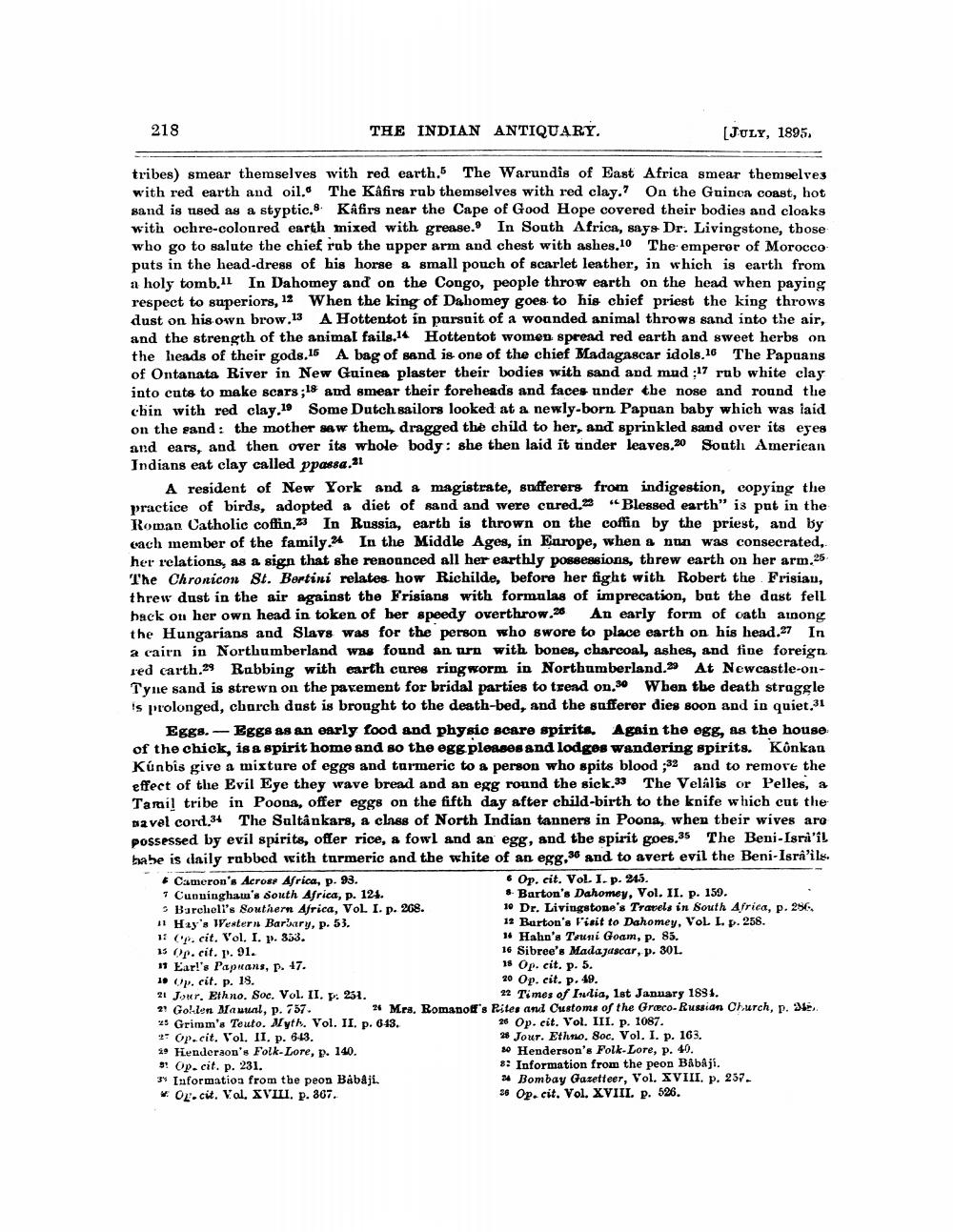________________
218
THE INDIAN ANTIQUARY.
[JULY, 1895.
tribes) smear themselves with red earth. The Warundis of East Africa smear themselves with red earth and oil. The Kâfirs rub themselves with red clay.? On the Guinea coast, hot sand is tused as a styptic.8. Kafirs near the Cape of Good Hope covered their bodies and cloaks with ochre-colon red earth mixed with grease. In South Africa, says Dr. Livingstone, those who go to salute the chief rub the upper arm and chest with ashes.10 The emperor of Morocco puts in the head-dress of his horse a small ponch of scarlet leather, in which is earth from a holy tomb. ll In Dahomey and on the Congo, people throw earth on the head when paying respect to superiors, 12 When the king of Dahomey goes to his chief priest the king throws dust on his own brow.13 A Hottentot in pursuit of a wounded animal throws sand into the air, and the strength of the animal fails.14 Hottentot women spread red earth and sweet herbs on the heads of their gods.15 A bag of sand is one of the chief Madagascar idols.16 The Papuans of Ontanata River in New Guinea plaster their bodies with sand and mud ;17 rub white clay into cuts to make scars;18 and smear their foreheads and faces under the nose and round the chin with red clay.19 Some Dutch sailors looked at a newly-born Papuan baby which was laid on the sand: the mother saw them, dragged the child to her, and sprinkled sand over its eyes and ears, and then over its whole body: she then laid it ander leaves 20 South American Indians eat clay called ppassa.31
A resident of New York and a magistrate, sufferers from indigestion, copying the practice of birds, adopted a diet of sand and were cared. “Blessed earth" is put in the Roman Catholic coffin 23 In Russia, earth is thrown on the coffin by the priest, and by vach member of the family.24 In the Middle Ages, in Europe, when a nna was consecrated, her relations, as a sign that she renounced all her earthly possessions, threw earth on her arm.25 The Chronicon St. Bertini relates how Richilde, before her fight with Robert the Frisiau, threw dust in the air against the Frisians with formalas of imprecation, but the dust fell back on her own head in token of her speedy overthrow.26 An early form of oath anong the Hungarians and Slavs was for the person who swore to place earth on his head.27 In a cairn in Northumberland was found an turn with bones, charcoal, ashes, and fine foreign red carth.29 Rubbing with earth cures ringworm in Northumberland.2 At Newcastle-onTyle sand is strewn on the pavement for bridal parties to tread on.30 When the death straggle 's prolonged, cbarch dust is brought to the death-bed, and the sufferer dies soon and in quiet,31
Eggs. - Eggs as an early food and physic scare spirits. Again the egg, as the house of the chick, is a spirit home and so the egg pleases and lodges wandering spirits. Konkan Kunbis give a mixture of eggs and turmeric to a person who spits blood ;32 and to remove the effect of the Evil Eye they wave bread and an egg round the sick.33 The Velalis or Pelles, a Tamil tribe in Poona, offer eggs on the fifth day after child-birth to the knife which cut the Bavel cord.34 The Sultankars, a class of North Indian tanners in Poona, when their wives are possessed by evil spirits, offer rice, a fowl and an egg, and the spirit goes.35 The Beni-Isra'il habe is daily rubbed with turmeric and the white of an egg,36 and to avert evil the Beni-Isra'ils. + Cameron's Across Africa, p. 93.
6 Op. cit. Vol. I. p. 245. 1 Cupuingham's South Africa, p. 124.
8. Barton's Dahomey, Vol. II. p. 159. Burchell's Southern Africa, VOL I. p. 268.
10 Dr. Livingstone's Travels in South Africa, p. 256. 11 Hey's IVestern Barbary, p. 53.
12 Burton's Fisit to Dahomey, VOL I. p. 258. 1 (p. cit. Vol. I. p. 333.
14 Haha's Tsuni Goam, p. 85. 15 Op. cit. p. 91.
16 Sibree's Madagascar, p. 30L. 11 Ear!'s Papuans, p. 47.
18 Op. cit. p. 5. 10 Op. cit. p. 19.
20 Op. cit. p. 49. 21 Jour. Ethno. Soc. Vol. II. V: 251.
22 Times of India, 1st January 1891. 2! Gollen Mauunl, p. 757.
Mrs. Romanolf's Rites anl Customs of the Greco-Russian Church, p.Me 25 Grimm's Teuto. Myth. Vol. II. p. 643.
26 Op. cit. Vol. III. p. 1087. 2: Op.cit. Vol. II. p. 643.
26 Jour. Etho. Soc. Vol. I. p. 163. 19 Henderaon's Folk-Lore, p. 140.
* Henderson's Folk-Lore, p. 49. 9! Op.cit. p. 231.
8: Information from the peon Babaji. 3% Informatioa from the peon Babaji.
24 Bombay Gazetteer, Vol. XVIII. p. 257. Op.cit. Vol. XVII. p. 867.
36 Op. cit. Vol. XVIII. p. 526.




